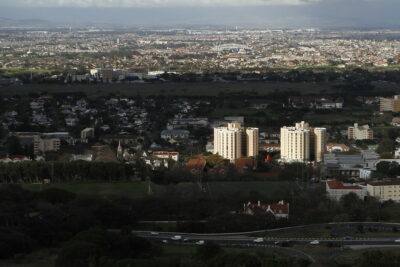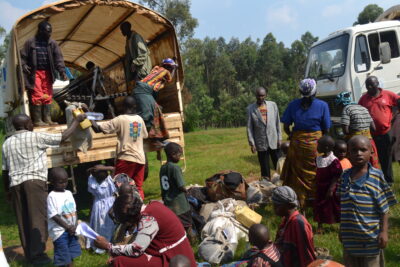Much has been said and written about Katrina in the last few weeks, but one glaring omission has been not incorporating the perspective of environmental justice activists, theorists and researchers. Environmental racism and environmental justice are particularly useful frameworks for understanding the devastating environmental, social and racial effects of Katrina’s impact and aftermath. The lack of attention paid to these frameworks are not a product of neglect, but reflective of three simultaneous erasures: the voices of the regional environmental justice activists themselves, environmental regulations in the unfolding redevelopment and rebuilding scandal, and the concept of environmental justice itself as articulated by the Bush Administration just weeks before Katrina hit.
At this point, there is a large literature on the problems of environmental racism and the emergence of the environmental justice movement.1The U.S. movement emerged in the 1980’s as a result of the confluence of events and reports that brought the terms “environmental racism” and “environmental justice” into the public domain. Reports documented the “unequal protection” from environmental pollution by local, state and national regulatory agencies. For a general overview of the movement, see Cole, L & Foster, S. From the Ground Up: Environmental Racism and the Rise of the Environmental Justice Movement. New York: New York University Press, 2000. Because it describes the disproportionate balance between high levels of pollution exposure for people of color and the low level of environmental benefits they enjoy, environmental racism can be defined as the unequal distribution of environmental benefits and pollution burdens based on race. Environmental justice is the name of the social movement that emerged in response to this problem to address a wide range of issues and communities.2These include military pollution on Native lands; occupational exposures (in the garment industry and in Silicon Valley factories staffed by Asian and Latino immigrant women workers); health effects of poor housing, such as lead poisoning; and consumption of contaminated fish by poor and immigrant communities.
Poor, rural Southern African-American communities were among the first to use the term environmental racism in fighting toxic siting.3The siting of a PCB facility in a predominantly African-American community in Warren County, North Carolina in 1982 is often considered the catalyst for the contemporary movement. Gulf Coast African-American environmental justice activists have been leaders of the national movement, in part because of the extensive problems they face from toxic/ chemical pollution from oil refineries and petrochemical facilities. Louisiana is home to over 125 oil and chemical plants in the chemical corridor known by some as “Cancer Alley,” between New Orleans and Baton Rouge, where a series of low-income, predominantly African-American rural communities live.4For an overview of environmental justice activism in the Gulf Coast region, see Roberts, J. T. & Weiss. M.T. Chronicles from the Environmental Justice Frontline. New York: Cambridge University Press, 2001. For the gender dimensions, see Allen, B. Uneasy Alchemy: Citizens and Experts in Louisiana’s Chemical Corridor Disputes. Cambridge: MIT Press, 2003. Most well known perhaps is Margie Eugene-Richard, who won the Goldman Prize in 2004. Richard – the first African-American to win the award, which some refer to as environmentalism’s Nobel Prize – had, with fellow residents of Diamond, waged a 30 year campaign against Shell Chemicals.5Lerner, S. Diamond: A Struggle for Environmental Justice in Louisiana’s Chemical Corridor. Cambridge: MIT Press, 2005.
Environmental justice activists in the Gulf Coast and elsewhere have argued that they are like “canaries in the mine,” facing the front-line of environmental and health risks. The “toxic soup” that has received much public attention is filled with the effluence from the oil and petrochemical industry, and stands as a visible manifestation of the everyday environmental and human disaster that poor, African-American Gulf Coast communities faced before Katrina on an everyday basis.
Thus, the Gulf Coast region was, in many ways, “Ground Zero” of the environmental justice movement, and its advocates led the way in publicizing the troubling racial disparity in exposure to pollution from the oil and petrochemical sectors. But environmental racism refers not only to the disparity of pollution effects, it also refers to the larger systemic problems that caused it, such as the exclusion of voices and perspectives of racial minorities and working-class populations from environmental policy-making. The term “transportation racism,” for example, is given by sociologists like Robert Bullard among others to the application of an environmental justice framework to transportation planning and policy.6Bullard, R., Johnson G. & Torres, A. Highway Robbery: Transportation Racism & New Routes to Equity. Cambridge: South End, 2004. And given that transportation is a key component of disaster planning and evacuation, the fact that the stranded were poor, black, disproportionately elderly, young and old, and without private transportation reflects dimensions of environmental racism.
Environmental justice is also a useful framework for understanding Katrina because it is an integrative approach that refuses a divide between the natural/ environmental and the social/ racial. Environmental justice expands the concept of environment to include public and human health concerns, in addition to natural resources such as air, land and water. Thus, taking an environmental justice perspective on Katrina necessarily refuses an analysis that divides natural and social disasters. This analysis is perhaps best represented by Eric Klinenberg’s account of how race and class intersected with the natural disaster discourse in Chicago’s 1995 heat wave that killed 700 Chicagoans, many of them poor and African-American. He rejects the rhetoric of natural disaster adopted by politicians as a simplified mode of explanation for who, why and how so many died.7One review of Heat Wave tells the sub-story of energy efficiency ratings in air conditioners, and draws connections between the energy efficiency debate and heat wave deaths. Inefficient air conditioner use and extra power demand lead to outages in critical times, such as heat waves. The strain on the grid led to power outages and air conditioning failures in Chicago during the 1995 heat wave. Gladwell, M. (2002, August 12). “Political Heat.” The New Yorker. Similarly, environmental justice activists reject race and class “neutrality” by forcing a closer look at who benefits and who bears the burdens of environmental and energy policies.
Years before Katrina hit, environmental justice activists were anticipating the racially disproportionate effects of climate change, in terms of coastal flooding and the health effects of heat waves, through the Environmental Justice and Climate Change Initiative (EJCC). The EJCC is a coalition of 28 U.S. environmental justice, climate justice, religious, policy, and advocacy groups that formed to pressure the Bush Administration and Congress on climate change and the Kyoto Protocol. As their 2002 fact sheet stated: “People of color are concentrated in urban centers in the South, coastal regions, and areas with substandard air quality. New Orleans, which is 62 percent African-American and 2 feet below sea level, exemplifies the severe and disproportionate impacts of climate change in the U.S.”8The fact sheet continues (and eerily predicts Katrina’s effects) that: “Global warming will hit the uninsured hardest…Global warming will increase the number of flood, drought and fire occurrences worldwide. Wealthy homeowners are able to move, whereas low-income people (who usually rent) cannot. Also, low-income people typically lack insurance to replace possessions lost in storms and floods. Only 25 percent of renters have renters insurance.” Retrievable at http://www.ejcc.org/.
Lastly, despite the centrality of environmental racism and environmental justice frameworks to understanding the racially disproportionate ways in which Katrina’s effects and its aftermath were and are being experienced, this analysis has been largely ignored in media, academic, and policy perspectives. In part, the lack of analysis stems from the literal disappearance of environmental justice activists from the region who, like millions of others, are displaced or in some cases perhaps dead. Without the vigilance of these environmental justice activists in the rebuilding effort, the clean-up and redevelopment of New Orleans will not include perspectives that prioritize environmental justice and community health concerns.9As reported by Featherstone, L. “Race to the Bottom,” September 8, 2005. Grist Magazine, Retrievable at http://www.grist.org/news/maindish/2005/09/08/featherstone-katrina/. For copies of the actual strategic plan draft, see http://www.epa.gov/compliance/resources/publications/data/planning/strategicplan/ej/. This trend is already exemplified by the Bush Administration’s temporary suspension of environmental regulations in the wake of rebuilding, which they hope to make permanent in reconstruction legislation (and that echo the Administration’s suspension of environmental regulations in the name of national security).10These include certain federal fuel standards designed to combat high ozone and sulfur emissions and the suspension of provisions of the Jones Act, which requires transport of petroleum, gasoline and other petroleum products on U.S.-flagged ships while operating in U.S. coastal waters. Curry, T. “Hurricane spawns flurry of deregulation,” September 12, 2005. MSNBC. Retrievable at http://msnbc.msn.com/id/9259887/. These early moves are part of a larger House effort by Republicans to ease environmental rules on refineries and look for ways to open new coastal waters to oil and gas development. Hebert, J. “House GOP Push to Ease Environmental Rules,” September 28, 2005. The Associated Press.
Although these moves to dismantle environmental laws are not surprising, they are particularly dangerous given the literal erasure of the meaning of environmental justice by the U.S. Environmental Protection Agency just weeks before Katrina. In June, the Administration announced that it was removing race and class from special consideration in its definition of environmental justice, pulling back from Clinton’s 1994 Executive Order on Environmental Justice which mandated that all federal agencies generate agency-specific strategies to address the disproportionate pollution experienced by minority communities, and set a controversial and abbreviated public comment period, ending just 10 days before Katrina hit.
Thus, the moment that the concept of environmental racism is being most attacked, is paradoxically the most crucial time to bring environmental justice back into the center of the analysis of Katrina in particular, and of how the health and environments of communities of color in the United States in general are fundamentally shaped by race and class considerations. Inserting an environmental justice framework into Hurricane Katrina ensures that the perspectives of local environmental justice activists, community and environmental health views on rebuilding New Orleans, and the concept of environmental justice in national policy terms, will not be easily erased. The vibrancy of the regional environmental justice movement was a product of local histories of economic development, environmental pollution, and race relations. With Katrina, we need to hear more, not less, from environmental justice activists who have been long engaged with the toxic, environmental and disaster politics in the region.












